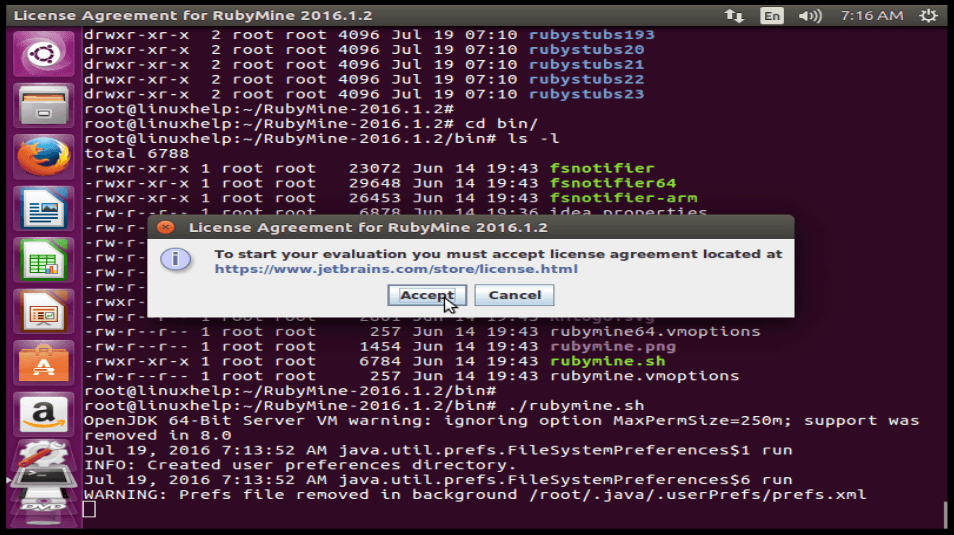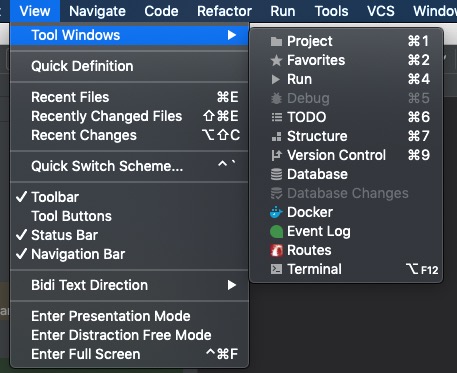

- #Rubymine terminal how to#
- #Rubymine terminal install#
- #Rubymine terminal code#
- #Rubymine terminal free#
- #Rubymine terminal mac#
Please consult the documentation for your CI server about how to do this. Continuous Integration ServersĮvery Continuous Integration server has a different mechanism for defining environment variables. IntelliJ IDEA / WebStorm / RubyMineĬlick the Run/Debug Configuration dropdown in the toolbar:Ĭlick on the Environment Variables field.Įnter the environment variable and its value into the dialog.Ĭheck the documentation for your editor, or help us improving this documentation by editing this page (link at the bottom of the page). If you specify a directory with an existing project, RubyMine opens this project. To do this, open up a terminal window on the Linux desktop. It starts by enabling the Snap package runtime (AKA Snapd). Installing the Snap version of RubyMine on Linux is easy. If you are using a terminal embedded in the IDE, see the Terminal section above. When you specify the path to a file, RubyMine opens it in LightEdit mode, unless it belongs to a project that is already open or there is special logic to automatically open or create a project (for example, in case of Maven or Gradle files). The RubyMine application is available as a Snap package for those who use Ubuntu and all Linux operating systems that support the Snap package format. To try this feature out, enable the flag in the Experimental Features dialog. Once an input command is matched, it is highlighted and you can press Ctrl-Enter to open a particular UI with the parameters fetched from the command. If you are using an editor or IDE to run Cucumber via a menu or shortcut, you shouldĭefine environment variables in the editor. RubyMine’s terminal can now parse various commands. Obviously the path is different when it is running inside docker. If the specs were running locally, the link would be clickable. I am running my specs inside a docker container through RubyMine.

Windows setx /M CUCUMBER_PUBLISH_TOKEN "some-secret-token"īash / Zsh export CUCUMBER_PUBLISH_TOKEN=some-secret-token I am not sure if this is really related to the RubyMine terminal or not, but anyway.
#Rubymine terminal code#
This also applies to terminals embedded in an editor such as Visual Studio Code or IntelliJ IDEA. If you are using a terminal to run Cucumber, you should define environment variables in the Typing RubyMine will show you RubyMine icon.
#Rubymine terminal install#
~/.bash_profile, ~/.zshrc, /etc.profile or similar.įor Windows users this means you should not define them via System/Control Panel or setx.exe. First, download and installed RubyMine snap package run following command: sudo snap install rubymine -classic After successful installation to start RubyMine via terminal run following command: rubymine Also start RubyMine from activities on Ubuntu. This guide describes how to define the CUCUMBER_PUBLISH_TOKEN environment variable withįor security reasons you should not define environment variables containing secrets globally.įor MacOS and Linux users this means you should not define them in ~/.bashrc, There are many different ways to define environment variables, depending on your environment. You’re ready to type Ruby code in the main window and run it.Cucumber uses environment variables to enableĬertain features, such as publishing Cucumber Reports. Give it a name and you’ll see it generate a file name with a *.rb extension.

Right click on the project folder => new => ruby file Give your new project a name and create it. If you want to ensure that all containers are up, I suggest simply running docker-compose up in a terminal before opening the project in. It’s what you chose when setting up the interpreter. In my case, I’m using ASDF to run Ruby 2.4.4. But RubyMine only really cares about the web container this is where your gems are, where your server runs, and where debugging takes place. Go to settings and under languages and frameworks select Ruby SDK and Gems. If you’re using a version manager with Ruby, then you have to select it in RubyMine. And to avoid problems with the rendering of these icons and not have these annoying ’ ’ in console. Many of these themes use special icons that are just for the purpose of customization (e.g github icon).
#Rubymine terminal free#
You can use the free 30 day evaluation license. There are different themes and settings for a nice look of your terminal.
#Rubymine terminal mac#
Use the default settings for now, including the keymap scheme and theme. Had set up rubymine in what i thought was the correct manner: The terminal on Mac works just fine, so does running it on the terminal inside the IDE as mentioned by Laurent Briais My solution was a bit hacky and definitely NOT the way that i think it should be done. Drag rubymine.sh to the terminal window and run it to install RubyMine. Download the Linux version of RubyMine.ĭecompress the tar.gz file and open /bin folder. Xubuntu comes with a Firefox web-browser. Although there are many options I prefer using a dedicated Ruby IDE such as RubyMine because it comes with debugging and autocomplete.īoth are critical when learning a programming language. You’re going to need a text editor to write Ruby.


 0 kommentar(er)
0 kommentar(er)
